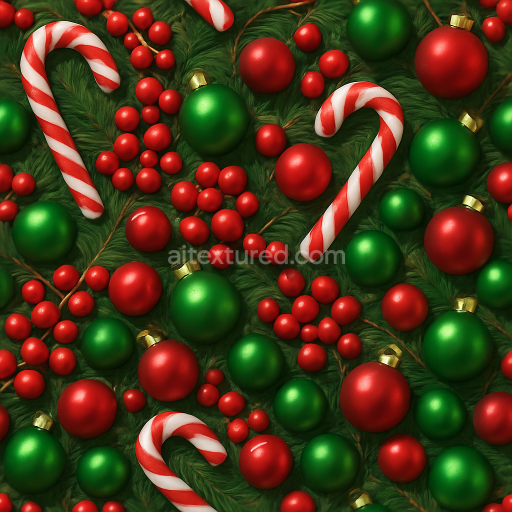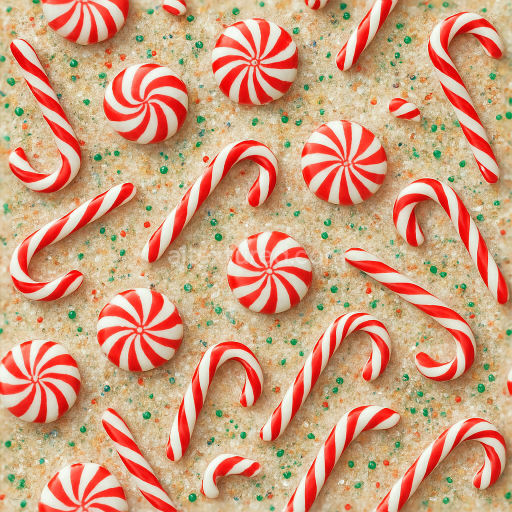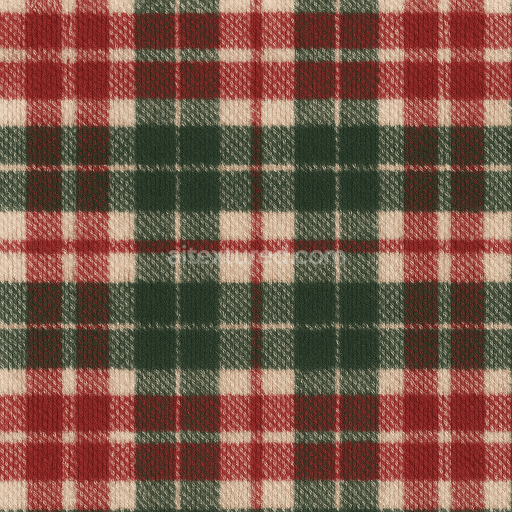The Seamless 3D texture titled "Peppermint Cotton Snow Wooden Floor Rustic Wood Pine Bark Firewood Stack" presents a complex and layered material composition that merges natural and festive elements into a unified surface. The primary substrate is aged rustic wood planks characterized by a weathered grain structure and subtle surface porosity that reflects years of exposure and use. This wooden base is interspersed with natural pine bark fragments adding an irregular rough texture with organic fissures and fine fibrous detail. Overlaying this is a delicate accumulation of cotton-like snow rendered with soft fibrous aggregates that simulate freshly fallen snow’s porous and matte surface. Accents of peppermint candy motifs are subtly integrated through pigment variations and a smooth glossy finish giving the impression of translucent sugar crystals embedded within the scene. The stacked firewood elements contribute volumetric depth and geometric variation appearing as tightly packed cylindrical forms with cracked bark surfaces and radial grain patterns.
From a materials science perspective the rustic wood substrate consists of cellulose fibers bonded by lignin and natural resins exhibiting a semi-rough surface finish that has been lightly brushed and weathered to expose grain and minor micro-cracks. The pine bark inclusions introduce a coarser composite layer with higher surface roughness and anisotropic fibrous directionality. The cotton snow layer is essentially a micro-fiber aggregate with high porosity and diffusive scattering characteristics modeled with a matte near-diffuse finish that contrasts the wood underneath. Peppermint elements are simulated through careful use of translucent gloss and subtle subsurface scattering achieved via pigment layering and smooth enamel-like coatings. The firewood stack’s bark textures feature a combination of rough cracked surfaces and soft mossy patches providing variation in microgeometry and reflectance. This multi-material composition creates a rich interplay of tactile qualities from slick and glossy to rough and fibrous.
In PBR terms the BaseColor (Albedo) map captures the natural brown and gray hues of the wood grain and bark the soft white and pale blue tones of the cotton snow and the deep reds and whites characteristic of peppermint candy. The Normal map conveys the intricate wood grain bark fissures and the delicate fiber structure of the snow layer enabling accurate light interaction with surface microgeometry. Roughness values range widely: polished peppermint areas exhibit low roughness for high specular clarity while snow and bark regions show high roughness for diffuse reflection. The Metallic map is predominantly black (non-metallic) as all materials are organic or resin-based. Ambient Occlusion enhances shadowing in crevices between wood planks bark cracks and firewood gaps. Height and Displacement maps provide subtle relief for the snow’s fluffiness and the bark’s rugged texture enhancing realism in close-up renders.
This texture is provided at an ultra-high 8K resolution ensuring exceptional detail fidelity suitable for close inspection in photorealistic renders. It is fully optimized for use in Blender Unreal Engine and Unity supporting all common PBR workflows. For best results it is recommended to carefully adjust the UV scale to maintain realistic wood grain proportions and avoid repetition artifacts. Additionally tuning roughness maps can help balance glossiness between peppermint candy highlights and matte snow surfaces. Combining height and normal maps strategically can improve the perception of depth on bark and firewood stacks without excessive geometry complexity making this texture ideal for seasonal interior scenes winter-themed environments and any project requiring a seamless richly detailed holiday atmosphere.
How to Use These Seamless PBR Textures in Blender
This guide shows how to connect a full PBR texture set to Principled BSDF in Blender (Cycles or Eevee). Works with any of our seamless textures free download, including PBR PNG materials for Blender / Unreal / Unity.
What’s inside the download
*_albedo.png — Base Color (sRGB)*_normal.png — Normal map (Non-Color)*_roughness.png — Roughness (Non-Color)*_metallic.png — Metallic (Non-Color)*_ao.png — Ambient Occlusion (Non-Color)*_height.png — Height / Displacement (Non-Color)*_ORM.png — Packed map (R=AO, G=Roughness, B=Metallic, Non-Color)

Quick start (Node Wrangler, 30 seconds)
- Enable the addon: Edit → Preferences → Add-ons → Node Wrangler.
- Create a material and select the Principled BSDF node.
- Press Ctrl + Shift + T and select the maps
albedo, normal, roughness, metallic (skip height and ORM for now) → Open.
The addon wires Base Color, Normal (with a Normal Map node), Roughness, and Metallic automatically.
- Add AO and Height using the “Manual wiring” steps below (5 and 6).
Manual wiring (full control)
- Create a material (Material Properties → New) and open the Shader Editor.
- Add an Image Texture node for each map. Set Color Space:
- Albedo → sRGB
- AO, Roughness, Metallic, Normal, Height, ORM → Non-Color
- Connect to Principled BSDF:
albedo → Base Colorroughness → Roughnessmetallic → Metallic (for wood this often stays near 0)normal → Normal Map node (Type: Tangent Space) → Normal of Principled.
If details look “inverted”, enable Invert Y on the Normal Map node.
- Ambient Occlusion (AO):
- Add a MixRGB (or Mix Color) node in mode Multiply.
- Input A =
albedo, Input B = ao, Factor = 1.0.
- Output of Mix → Base Color of Principled (replaces the direct albedo connection).
- Height / Displacement:
Cycles — true displacement
- Material Properties → Settings → Displacement: Displacement and Bump.
- Add a Displacement node: connect
height → Height, set Midlevel = 0.5, Scale = 0.02–0.08 (tune to taste).
- Output of Displacement → Material Output → Displacement.
- Add geometry density (e.g., Subdivision Surface) so displacement has polygons to work with.
Eevee (or lightweight Cycles) — bump only
- Add a Bump node:
height → Height.
- Set Strength = 0.2–0.5, Distance = 0.05–0.1, and connect Normal output to Principled’s Normal.
Using the packed ORM texture (optional)
Instead of separate AO/Roughness/Metallic maps you can use the single *_ORM.png:
- Add one Image Texture (Non-Color) → Separate RGB (or Separate Color).
- R (red) → AO (use it in the Multiply node with albedo as above).
- G (green) → Roughness of Principled.
- B (blue) → Metallic of Principled.
UVs & seamless tiling
- These textures are seamless. If your mesh has no UVs, go to UV Editing → Smart UV Project.
- For scale/repeat, add Texture Coordinate (UV) → Mapping and plug it into all texture nodes.
Increase Mapping → Scale (e.g., 2/2/2) to tile more densely.
Recommended starter values
- Normal Map Strength: 0.5–1.0
- Bump Strength: ~0.3
- Displacement Scale (Cycles): ~0.03
Common pitfalls
- Wrong Color Space (normals/roughness/etc. must be Non-Color).
- “Inverted” details → enable Invert Y on the Normal Map node.
- Over-strong relief → lower Displacement Scale or Bump Strength.
Example: Download Wood Textures and instantly apply parquet or rustic planks inside Blender for architectural visualization.
To add the downloaded texture, go to Add — Texture — Image Texture.

Add a node and click the Open button.

Select the required texture on your hard drive and connect Color to Base Color.





















